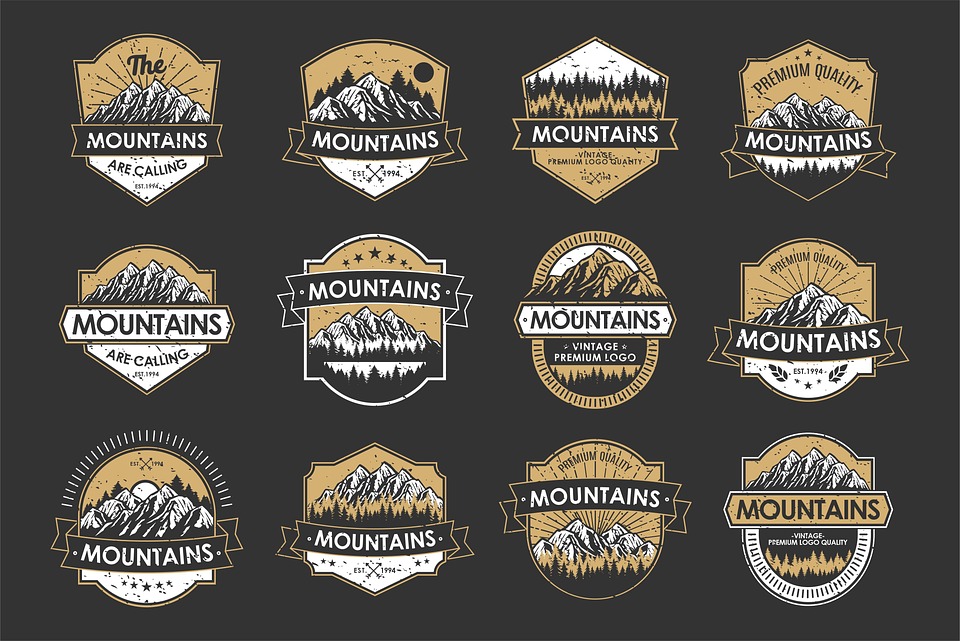The Evolution of Emblems: How Modern Logos Are Redefining Brand Identity
Logos, once a simple representation of a company’s name or initials, have undergone a significant transformation in recent years. Gone are the days of static, two-dimensional designs that failed to capture the imagination of consumers. Today, modern logos are innovative, dynamic, and integral to a brand’s overall identity. In this article, we’ll explore the evolution of emblems, from their humble beginnings to their modern form, and examine how they’re revolutionizing the way brands connect with their audiences.
The Early Years: Simple, Yet Effective
The first logos date back to the 18th century, when companies used simple, hand-drawn designs to symbolize their names. These early emblems were often static, featuring a few bold lines and minimal illustrations. As trade and commerce grew, the need for more sophisticated branding strategies emerged. In the late 19th century, companies began to adopt more complex, illustrative designs that showcased their products or services. The iconic trademarks of companies like Coca-Cola (1891) and Ford (1903) are testaments to the power of early logo design.
Mid-Century Modernity: The Rise of Typography
By the mid-20th century, logo design had evolved to incorporate typography. Helvetica, a sans-serif font created in 1957, became a go-to choice for many companies, including those in the tech and finance industries. The use of typography allowed logos to convey a sense of professionalism, modernity, and sophistication. The iconic logos of Apple (1977) and IBM (1972) are examples of how typography can be used to create memorable and recognizable brand identities.
Postmodernism and the Era of Illustration
The 1980s saw a shift towards more playful, illustrative designs. Companies began to use logos that featured playful characters, abstract shapes, and imaginative illustrations. The rise of postmodernism, a design movement that celebrated creativity and experimentation, led to the development of logos that were more expressive and emotionally resonant. The logos of Starbucks (1987) and Virgin Atlantic (1984) are examples of the playful, illustrative styles that emerged during this period.
Digital Age: The Rise of Dynamic, Interactive Logos
In the 21st century, logos have become even more dynamic, with the advent of digital technology and social media. Companies are now using interactive logos, animations, and motion graphics to engage their audiences and create memorable brand experiences. The iconic logos of Google (1998) and Facebook (2005) feature simple, yet effective, designs that adapt to different contexts and platforms.
Trends and Innovations
Today, modern logos are pushing the boundaries of brand identity, incorporating cutting-edge technology and innovative design techniques. Some of the latest trends include:
- 3D Logos: With the advent of augmented reality (AR) and virtual reality (VR), logos are now being created in three dimensions, allowing for immersive experiences and new ways of interacting with brands.
- Dynamic Logos: Dynamic logos that change shape, color, or layout in response to user interactions or environmental stimuli are becoming increasingly popular.
- Abstract Illustrations: Abstract illustrations, often generated using AI algorithms, are being used to create unique, visually striking logos that captivate audiences.
- Customizable Logos: With the rise of personalization, companies are incorporating customizable logos that allow users to personalize their brand experiences.
Conclusion
In conclusion, the evolution of emblems has been a remarkable journey, from simple, static designs to dynamic, interactive masterpieces. Modern logos are no longer mere representations of a company’s name or initials; they’re integral to a brand’s overall identity, conveying values, personalities, and emotions. As technology continues to advance, we can expect logos to continue pushing the boundaries of creativity, innovation, and brand engagement.
#Evolution #Emblems #Modern #Logos #Redefining #Brand #Identity





**mind vault**
mind vault is a premium cognitive support formula created for adults 45+. It’s thoughtfully designed to help maintain clear thinking
Dort erhalten Sie umgehend Unterstützung von einem der dortigen professionellen Kundensupport-Mitarbeiter.
Der Mindesteinzahlungsbetrag beträgt 10 € bei FIAT-Währungen und 5 €
für Kryptowährungen. In diesem Bereich können Sie eine ganze Menge der
besten und neuen Slots der Branche vorfinden, und zwar u.a.
Sobald Sie dies getan haben, erhalten Sie eine Bestätigungs-E-Mail an die von Ihnen angegebene E-Mail-Adresse.
Die Website bietet auch eine Vielzahl von Zahlungsmethoden an, darunter verschiedene E-Wallets und
Kryptowährungen wie Bitcoin. Der Zugang zu den Spielen ist über PC oder mobile Geräte möglich, die Spielbibliothek ist HTML5-basiert und bietet eine reibungslose Erfahrung
auf mobilen Geräten. Wir bieten Ihnen täglich eine Vielzahl von Spielen an, darunter Slots, Tischspiele, Live-Casino-Spiele und viele mehr.
Mit unserem VIP-Programm erhalten Sie exklusive Boni, Cashback-Angebote und andere attraktive Vorteile.
Wenn der Spieler die Spiele mit den realen Geldeinsätzen spielen will,
ist es nötig, eigenen Account zu registrieren. SolCoins kann man für die Einsätze in den Gesellschaftsspielen oder Live Casino Spielen nicht bekommen. Um sich für einen Preis zu qualifizieren, müssen Spieler in den Qualifikationsspielen die
höchstmöglichen Einsätze tätigen. Wenn Sie regelmäßig um echtes Geld spielen und Einzahlungen tätigen, können Sie Ihren Bonus ganz
einfach freischalten. Sie können einen 75 %-Bonus mit einem Höchstbetrag von bis zu 300 € spielen.
References:
https://online-spielhallen.de/starda-casino-erfahrungen-ein-umfassender-uberblick-fur-spieler/
Denn neben einem klassischen Willkommensbonus,
der mit 8.000€ recht üppig ausfällt und dem VIP-Bonus von bis zu
60.000€, werden alle potenziellen Kunden gleichwohl angesprochen. In unserem Testbericht gehen wir nun näher auf die Spielauswahl
ein, ob es aktuell gültige Immerion Casino Bonuscodes gibt und an welchen Stellen wir uns noch etwas
Nachbesserung wünschen würden. Auch spannende Live Gameshows sind im Immerion Casino mit am Start, unter anderem in Form von Extra Chilli Epic Spins, Funky Time,
Sweet Bonanza Candyland, Cash or Crash live,
Crazy Time oder Mega Wheel. Man kann also nicht genau erkennen, wie viele Roulettespiele oder
Blackjack Tische vorhanden sind, da alle Live
Spiele in eine einzige große Liste geklatscht
wurden. Bei einem erhaltenen Bonusbetrag in Höhe von 100 Euro würde
die Gewinngrenze somit 1.000 Euro betragen. Zudem
gilt es zu beachten, dass mit erhaltenem Bonusguthaben maximal das 10-fache
an Gewinnen erspielt werden kann.
Zudem arbeitet das Casino eng mit Organisationen zusammen, die
sich auf die Prävention und Behandlung von problematischem Spielverhalten spezialisiert haben. Immerion engagiert sich aktiv
für verantwortungsvolles Glücksspiel und stellt Spielern verschiedene Hilfsmittel
zur Verfügung, um ihr Spielverhalten besser kontrollieren zu können. Zusätzlich
bietet Immerion Casino auf der eigenen Webseite eine umfangreiche FAQ-Sektion. Das Casino bietet seine Webseite in mehreren Sprachen an, darunter Deutsch, Englisch und Französisch, wodurch es internationale Spieler anspricht.
Die Mindesteinzahlung liegt bei 10 Euro, was insbesondere für Spieler attraktiv
ist, die zunächst kleinere Summen einsetzen möchten.
References:
https://online-spielhallen.de/buran-casino-login-ihr-tor-zur-welt-des-online-glucksspiels/
MGM’s in-house slots rotate regularly and include progressive jackpots that are tied to the company’s land-based resorts.
It’s the most reliable casino platform
in the U.S. right now, both in terms of payout consistency and day-to-day functionality.
BetMGM doesn’t try to be everything to everyone; it just runs well, pays out fast,
and adds real value via rewards and game variety.
All of the platforms were tested with real money
and lots of sessions. Some of them bury their terms and conditions,
stall payouts, or load their game lobbies with filler just so they hit a
certain number. Some might be restricted in your
country, while others will only offer email customer support.
An online casino index is an up-to-date listing of casinos that you can play at.
Whether you prefer slots, table games, video poker, or specialty games,
all of them are available for real money play. Web wallets like Neteller and Skrill are available,
though PayPal isn’t accepted at US online casinos.
Also, many US online casinos accept Bitcoin and other cryptocurrencies.
Let’s take a look at the most popular among
Australian casino site players. Instead, they give access to free casino games.
So what features does the best Australian online casino possess?
Let’s start with our experts’ choice of the top AU casino
sites to play at legally. He loves getting into the nitty gritty
of how casinos and sportsbooks really operate in order…
Yes, almost all live dealer platforms are fully optimised for mobile play,
working smoothly on both iOS and Android devices through your browser or dedicated casino apps.
Look for games with lower minimum bet requirements to get
more spins and rounds out of your current budget at the best Australian online casino.
If you are new to live gaming, choose classic table games with lower limits
to get familiar with the live interface and
real-time pace. Online pokies for real money are
the most popular casino game in Australia. Top Aussie casinos often stand
out because of welcome bonuses, reloads, free spins and cashback that extend
playtime. The best Australian online casinos share several characteristics, but the best of them provide all the following.
We’ve investigated and reviewed the top online casinos in Australia to give you a sense of what to expect.
By using the “SECRET-20” promo code while creating an account at Uptown Pokies, punters get
a casino welcome package.
For instance, the wagering requirement will determine how many times the punter has
to bet the $10 reward to turn it into real cash.
Irrespective of the reward the casino promises, it is important to look
through the requirements before activating the reward.
Simply use the “CASINORITY” promo code during account creation, and
you’re ready to enjoy your bonus rounds on The Dog House Megaways slot machine.
We highlight the important aspects of every bonus before presenting it
to you. More and more gambling enthusiasts are turning to mobile versions.
Some sites request that the punter use a promo code to activate the reward, while some other offers are activated with deposits.
Casinos develop their unique promo formats, but there are some categories that you’d find in every Aussie online casino you visit.
Other promotions include weekly and monthly bonuses, birthday gifts, free spins, tournaments,
and also loyalty points earned by regular playing. So, as you can see, one is able
to get a huge amount of real money for playing. 100% or
even 200% match is a good offer, and the players are allowed to
deposit up to $1,000 or even a bit more. The full list of online casino reviews is in the “Reviews” section of the
main menu of our site.
No deposit casinos are not easily found, at least from legitimate casinos,
but they make all the difference in your gambling experience.
If you suffer from gambling addiction, you should necessarily contact a gambling addiction help
center and not play for real money. You have to double-check whether each particular
website accepts online casino AUD. To give it a try right now, use Casinority filter to find cool real money casinos.
Night Light reduces blue light emission from your screen, making it easier on the eyes in low-light conditions
and can help with better sleep. Yes, many laptops have
function keys designated for brightness adjustment, often represented by sun icons with
plus and minus signs. You can enable it in the Display settings if your device
supports it. If you can’t adjust the brightness, it could be due to an outdated graphics
driver.
“Don’t Feel Like Feeling Sad Today” was the third single, released 29 June 2022.
“Tongue Tied” was released 13 November alongside the
music video, starring Joey King, on YouTube. On 31 October
2019, the music video for “Die a Little” from the 13 Reasons Why soundtrack was released.
You can easily adjust the screen brightness of your Windows 10 computer in the Settings menu.
The music video for the single was released on YouTube the
same day, featuring an appearance from YouTuber and Twitch streamer Valkyrae.
For laptops equipped with light sensors, this feature is
especially beneficial as it continually adjusts the brightness for your comfort throughout
the day.
References:
https://blackcoin.co/paris-las-vegas-hotel-casino-adults-only/
online slots paypal
References:
ahsazglobal.in
casino online paypal
References:
didiaupdates.com
us online casinos that accept paypal
References:
https://kaymack.careers/employer/best-65-sites/
us online casinos paypal
References:
https://collisioncommunity.com/employer/best-paypal-casinos-2025-100-real-money-paypal-sites-️/
online casino for us players paypal
References:
https://hirepestpro.com/
online casino usa paypal
References:
http://www.jonkyotra.online